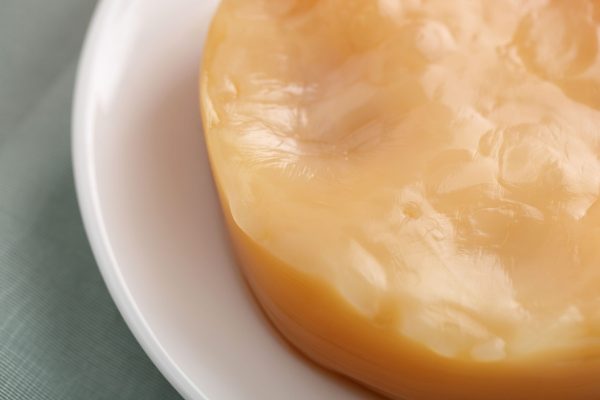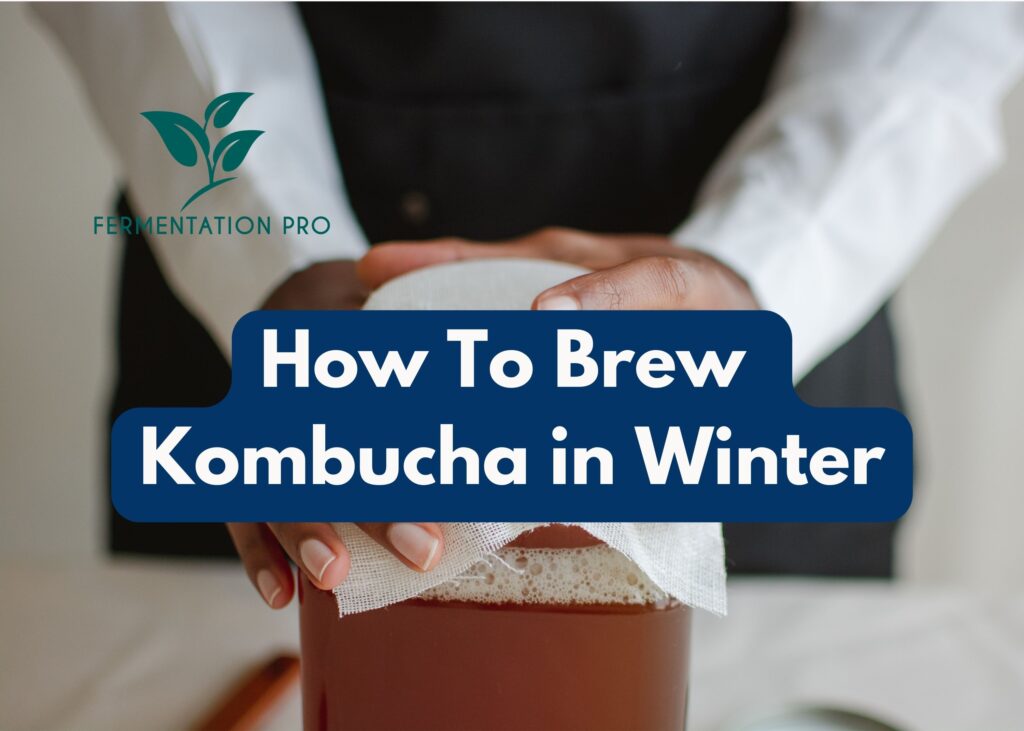For many brewers, the thought of brewing Kombucha during winter is not always the best idea. Kombucha is a fermented beverage that is best brewed at warm temperatures of 75℉ to 85℉. During winter, the temperature ranges from 2.6℉ to 67℉ depending on the country. While Kombucha can brew at a temperature as cold as 60℉, the fermentation process is relatively slow and you can’t expect your Kombucha to finish fermentation as fast and easily as it does in higher temperatures. Hence, knowing how to brew in winter comes in handy to achieve brewing success even when the temperature is not on your side.
The method of brewing Kombucha in winter is similar when brewing in summer or other seasons however the brewing time will be longer and you will have to monitor the temperature to prevent your brew from getting too cold. You can do this by using a strip thermometer and other fermentation aids. In addition to that, you will have to consider where to store your Kombucha and make sure that the place is warm enough to keep your brew healthy.
When brewing in winter, you will have to make your Kombucha as usual by making the sweet tea and adding in the starter tea and SCOBY. After that, allow your Kombucha to undergo first fermentation for 7 days and more. Start tasting after 7 days and when the taste already suits your liking, you can transfer the Kombucha to bottles for the second fermentation.
The second fermentation of Kombucha is for flavoring and carbonation. After bottling your Kombucha, add your preferred flavoring to the bottles such as fruits, essential oils, vegetables, and more. Next, seal the bottles tightly and allow fermentation for up to 14 days. Start tasting after 3 days of fermentation and if the taste is already good for you, store the bottled Kombuchas in the fridge.
If it’s your first time brewing Kombucha in winter and still anxious about whether you can do it or not, here are some tips that can help you achieve brewing success.

Table of Contents
Tips For Brewing Kombucha In Winter
Choose a Warm Fermentation Station
Different places in a house can have different temperatures. Choosing a warm spot for brewing your Kombucha can help maintain its warm temperature without having to spend any penny or much effort.
Here are just some of the usual warm spots in a house.
- Near warm appliances like television, radiator, oven, heater, and refrigerator
- Warm rooms in the house like a laundry room
- High cupboard
- Near the furnace
Use Heating Pad
If you have an extra budget, you may want to consider investing in a heating pad to keep the temperature of your Kombucha warm in winter. We recommend buying a heating pad with a thermostat to not just keep your Kombucha ferment warm but also give you accurate temperature readings so you can brew your Kombucha properly.
Wrap Christmas Lights Around the Kombucha Brewing Vessel
This idea may not sound the most ideal, but it works especially if your house’s temperature is low and you are trying to save money on heating equipment. Just wrap the Christmas lights around the brewing vessel and not just on one part to ensure that the heat is evenly distributed all over the vessel.

Can I Make Kombucha In Winter?
The short answer is yes. However, it will not be as easy as fermenting in seasons with warmer temperatures so you’ll need extra patience. First of all, Kombucha fermented in winter takes longer to complete fermentation. The slow fermentation process also makes Kombucha more prone to molds. Below we discuss these in more detail.
Disadvantages of Brewing Kombucha In Winter
Slow Fermentation
The cold temperature in winter causes the yeast and bacteria in the SCOBY to become weak and slow down the fermentation process. You will notice that your Kombucha will take longer to change its taste to a distinct tart flavor of Kombucha. If your Kombucha hasn’t changed its taste yet after a few days, just continue brewing your Kombucha. However, watch out for signs of mold.
Mold Growth
Due to the slow fermentation, Kombucha also takes longer to get acidic. The high acidity of Kombucha protects it from harmful microorganisms. Without high acidity levels, molds and other harmful microorganisms can easily contaminate the brew. For this reason, you have to make sure that your Kombucha’s surrounding is clean and away from possible sources of contaminants that can cause mold like trash or other damp surfaces.
In addition to keeping your fermentation station clean, you may also double the amount of starter tea you use in your Kombucha brew. The starter tea liquid is naturally acidic and can help acidify your Kombucha faster. In addition to that, adding more starter tea can ferment Kombucha faster.
Sweeter taste
This is not entirely a disadvantage of brewing Kombucha in winter as some enjoy sweet Kombucha, however for those who like strong-tasting Kombucha, this is not good news. The cold temperature in winter makes the bacteria culture less active leading a slower fermentation progress. everythingkombucha.com describes the taste of Kombucha brewed at cold temperatures as milder, sweeter, and weaker. Kombucha made in winter is best served to children and beginner Kombucha drinkers.

How Cold Is Too Cold To Ferment Kombucha?
Kombucha can be brewed at a temperature range of 60℉ to 85℉ however the best brewing temperature is 75℉ to 85℉. A temperature below 60℉ is considered too cold to ferment Kombucha and can keep the bacteria culture inactive.
How to Know if the Temperature is Too Cold
You’ll need a thermometer to take a temperature reading and know if the brew’s temperature is too cold. It’s best to use a strip thermometer to measure the temperature of the Kombucha. A strip thermometer is an adhesive device that can easily stick to the side of your brewing jar. Once attached, it will provide a continuous temperature reading that is easy to read. This will allow you to monitor your temperature and make adjustments accordingly.
How to Prevent Your Kombucha from Getting Too Cold
It’s impossible to prevent the temperature from dropping especially in winter but you can prevent your Kombucha from getting too cold. Continue reading to find out the best ways to prevent this situation.
Monitor your kombucha’s temperature regularly
Using a temperature strip, monitor your Kombucha’s temperature to prevent it from getting too cold. A temperature strip is a type of adhesive thermometer that can measure the temperature of an object. You can stick it on your Kombucha brewing vessel to get an accurate reading of the brew’s temperature. With a temperature strip, you can easily prevent your brew from getting too cold.
Use a heating pad
The best option to prevent the Kombucha temperature from getting too cold is by using a heating pad. Heating pads provide a convenient solution to maintaining the temperature of your Kombucha brew without you having to check on it very often. The pad is wrapped around the brewing container and secured using a band. If the temperature is not that cold, you may just place it under your Kombucha brewer to aid with temperature control.
What to Do When the Kombucha’s Temperature Suddenly Drop
Temperature drops are inevitable. In case your Kombucha brew was left fermenting at a too-cold temperature, you can simply warm it up and leave it to ferment again. To warm up your Kombucha ferment, take a thick towel and wrap it around the fermenter. Next, transfer it to a warmer spot and let it warm up. You may also wrap the heating pad around your fermenter to raise the temperature of the brew.
If your Kombucha has been left to ferment in cold temperatures for too long and you see visible signs of mold buildup, we recommend disposing of your entire brew and starting over again. Consuming Kombucha that is potentially contaminated by mold will not just give you a bad drinking experience but can also cause potential health risks.
What Happens if Kombucha is Too Cold?
When you are brewing Kombucha in a cold place, the cold temperature will interfere with your Kombucha’s fermentation progress. The Kombucha culture does not perform well in cold temperatures and will ferment your Kombucha slower. This means that you will have to brew your Kombucha for a longer time. This can take days up to weeks of additional waiting time.
If the temperature goes lower than the suggested brewing temperature which is 60℉ to 85℉, the Kombucha culture can completely go dormant and stop the fermentation. When the fermentation stops, Kombucha’s acidity will also develop slowly. Kombucha’s acidity keeps it safe from harmful microorganisms. Without it, the Kombucha will become prone to the growth of molds.
Can SCOBY Survive Cold?

While many brewers can safely store their SCOBYs in the fridge for several months, we do not suggest doing. Storing SCOBY in a cold place below 60℉ can affect its health. The cold temperature can negatively impact the SCOBY’s live cultures causing them to completely go dormant and may become unable to ferment.








